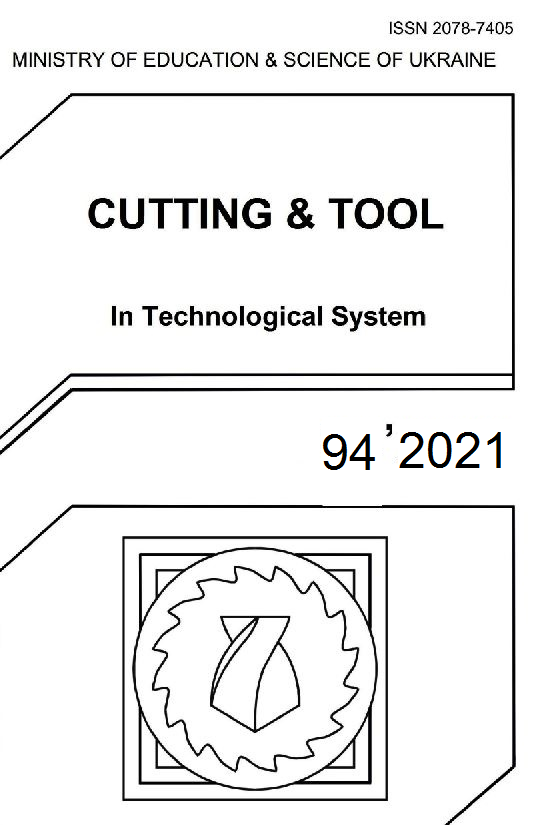INVESTIGATION OF THE EFFECT OF AREAL ROUGHNESS MEASUREMENT LENGTH ON FACE MILLED SURFACE TOPOGRAPHIES
DOI:
https://doi.org/10.20998/2078-7405.2021.94.07Abstract
Surface roughness is of great importance in the manufacturing industry, as it affects surfaces’ tribological properties (wear, friction, lubrication, etc.), corrosion resistance, fatigue strength and appearance. Areal roughness measurement, which provides a more comprehensive characterization of surfaces, is becoming increasingly popular, but systematic studies are still lacking, so measurements are often analyzed differently. In this paper, the effect of the measurement length is analyzed in the main measurement direction on areal roughness of face milled surface topographies, which were measured with a confocal chromatic sensor.
References
Pomberger, S., Stoschka, M., Leitner, M.: Cast surface texture characterisation via areal roughness, Precision Engineering vol.60 (2019) pp.465-481
Eifler, M., Klauer, K., Kirsch, B., Seewig, J., Aurich, J. C.: Micro-milling of areal material measures–influences on the resulting surface topography, Procedia CIRP vol.71 (2018) pp.122-127
Karpat, Y.: Influence of diamond tool chamfer angle on surface integrity in ultra-precision turning of singe crystal silicon, The International Journal of Advanced Manufacturing Technology vol.101(5) (2019) pp.1565-1572
Zak, K.: Areal field and fractal based characterization of hard surfaces produced by different machining operations, Journal of Machine Engineering vol.16(1) (2016) pp.24-32
Wüst, P., Edelmann, A., Hellmann, R.: Areal surface roughness optimization of maraging steel parts produced by hybrid additive manufacturing, Materials vol.13(2) (2020) ArtNo:418
Cabanettes, F., Joubert, A., Chardon, G., Dumas, V., Rech, J., Grosjean, C., Dimkovski, Z.: Topography of as built surfaces generated in metal additive manufacturing: a multi scale analysis from form to roughness, Precision Engineering vol.52 (2018) pp.249-265
Charles, A., Elkaseer, A., Thijs, L., Hagenmeyer, V., Scholz, S.: Effect of process parameters on the generated surface roughness of down-facing surfaces in selective laser melting, Applied Sciences vol.9(6) (2019) ArtNo:1256
Nagy, A.: Influence of Measurement Settings on Areal Roughness with Confocal Chromatic Sensor on Face-milled Surface, Rezanie i Instrumenty v Tekhnologicheskih Sistemah vol.93 (2020) pp.65-75
Kundrák, J., Gyáni, K., Felhő, C., Deszpoth, I.: The effect of the shape of chip cross section on cutting force and roughness when increasing feed in face milling, Manufacturing Technology vol.17(3) (2017) pp.335–342
Kundrák, J., Felhő, Cs.: 3D Roughness Parameters of Surfaces Face Milled by Special Tools, Manufacturing Technology vol.16(3) (2016) pp.532-538
Varga, G., Kundrák, J.: Effects of technological parameters on surface characteristics in face milling, Solid State Phenomena vol.261 (2017) pp.285-292
Nagy, A., Kundrák, J.: Changes in the values of roughness parameters on face-milled steel surface, Rezanie i Instrumenty v Tekhnologicheskih Sistemah vol.92 (2020) pp.85-95
David Whitehouse: Surfaces and their Measurement. Butterworth-Heinemann, Oxford, 2004
Todhunter, L. D., Leach, R., Lawes, S., Blateyron, F.: Industrial survey of ISO surface texture parameters. CIRP Journal of Manufacturing Science and Technology, vol.19. (2017) pp. 84-92
Downloads
Published
Issue
Section
License
Copyright Notice
Authors who publish with this Collection agree to the following terms:
1. Authors retain copyright and grant the Collection right of first publication with the work simultaneously licensed under a Creative Commons Attribution License that allows others to share the work with an acknowledgement of the work's authorship and initial publication in this Collection.
2. Authors are able to enter into separate, additional contractual arrangements for the non-exclusive distribution of the Collection's published version of the work (e.g., post it to an institutional repository or publish it in a book), with an acknowledgement of its initial publication in this Collection.
3. Authors are permitted and encouraged to post their work online (e.g., in institutional repositories or on their website) prior to and during the submission process, as it can lead to productive exchanges, as well as earlier and greater citation of published work.

